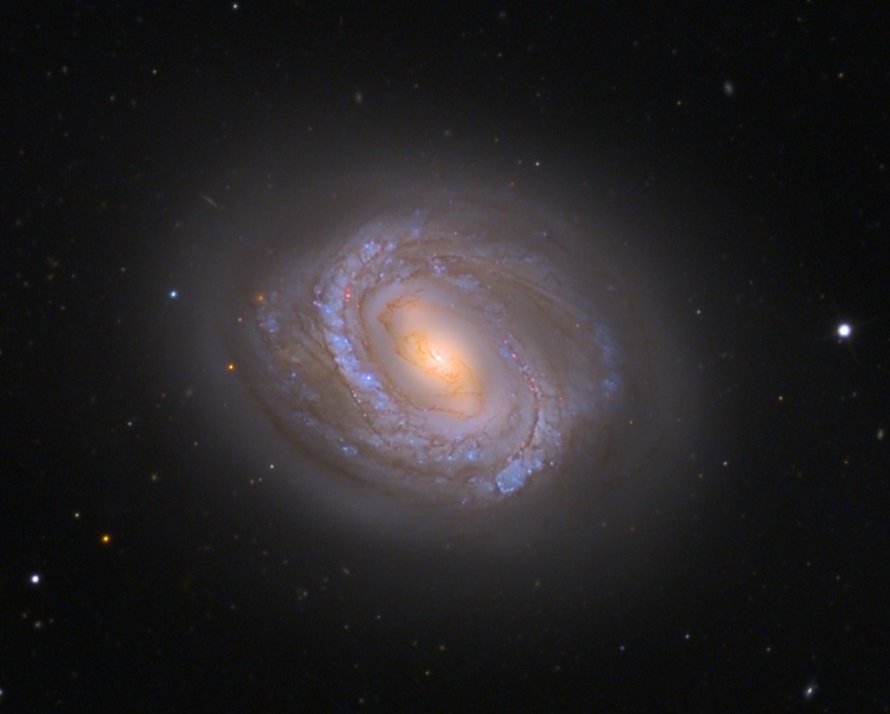M58 (NGC 4579)
Messier 58 (NGC 4579) is a barred spiral galaxy located in the constellation Virgo in the Virgo Cluster of galaxies. M58 is 62000000 light years away from Earth.
M58 is best viewed during late spring, is magnitude 10.5, and can be viewed with small telescope. M58 is 6.1' x 4.7' in apparent size. For reference, the full moon is 30'.
Observing difficulty: Hard
- Name:
- Type:
- barred spiral galaxy
- Constellation:
- Virgo
- NGC or IC:
- NGC 4579
- Magnitude:
- 10.5
- Viewing:
- small telescope
- Size:
- 6.1' x 4.7'
- Distance (light years):
- 62000000 LY
- RA:
- 12h 37.8m
- Dec:
- 11 50'
- Season:
- late spring
- Galaxy group:
- Virgo Cluster
- Messier Marathon #:
- 60
* The naked eye can see up to magnitude ~7-8 objects under ideal dark sky conditions.
The Spiral Galaxies of the Virgo Cluster
Messier 58 (M58) is one of the brighter members of the Virgo Cluster of galaxies and was one of the first objects of its kind to be identified as a spiral galaxy. Its unique characteristics and relative proximity make it a captivating object of study and observation for astronomers worldwide.
Historical Context
Charles Messier first discovered M58 on April 15, 1779. It is one of the earliest recognized spiral galaxies, having been classified as such by Lord Rosse in the 19th century, along with M99 and M100. M58 is also one of the 2,000 galaxies that make up the Virgo Cluster, a massive galaxy cluster in the constellation Virgo.
Physical Characteristics
M58 is classified as a barred spiral galaxy because of the bar-shaped band of stars and gas crossing through its nucleus. This galaxy spans about 80,000 light-years, making it slightly smaller than our Milky Way Galaxy. The galaxy has an estimated mass of about 160 billion solar masses, which includes the stars, gas, dust, and the dark matter inferred to be there by its gravitational effects.
Magnitude and Size
With an apparent magnitude of 10.5, M58 isn't visible to the naked eye, but it can be observed with a small telescope under dark skies. The galaxy's surface brightness, however, is relatively high due to its compact size and significant star formation. The galaxy spans approximately 5.9 x 4.7 arcminutes in size, making it appear about one-sixth the width of the full moon.
Scientific Significance
M58 is an active galaxy with a well-defined nucleus classified as a Seyfert type 2 galaxy, one of the two main types of active galaxies. Seyfert galaxies like M58 have quasars at their cores. The supermassive black hole at the center of M58 has an estimated mass of 70 million solar masses, significantly impacting the galaxy's overall dynamics and the formation of new stars.
Finding and Viewing Messier 58
M58 is located in the constellation Virgo and can be found about 3.5 degrees northeast of the bright star Gamma Virginis. Its visibility is strongly affected by light pollution. Under dark skies, it's readily observable in a small telescope or even large binoculars.
In a 4-inch telescope under optimal conditions, M58 may appear as a small, faint oval patch of light. Larger telescopes, especially those equipped with CCD cameras and used in long-exposure photography, can begin to reveal the galaxy's structure, including its bright central region and hints of its spiral arms.



